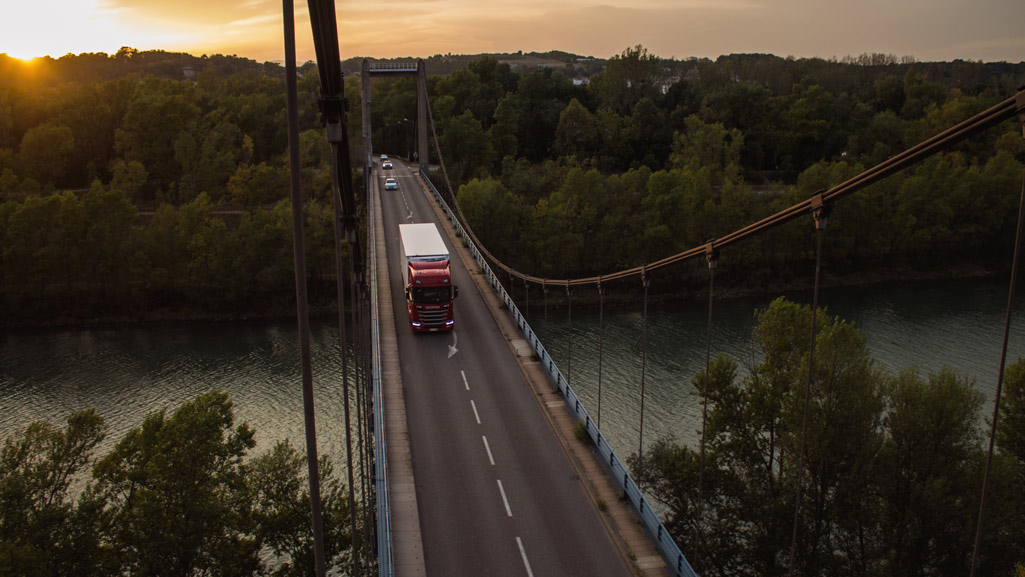The EU project TransformingTransport looks at ways to use Big Data in order to increase transport efficiency and generate environmental benefits. Various areas of application are examined in pilot projects. Jasmin Graf, who is managing the Sustainable Connected Trucks project on the PTV side, explains how lost time can be recovered, saving both time and money.
One of the objectives of this project is to show the value of Big Data for logistics providers based on specific measurable and verifiable examples. How is this principle applied to the Sustainable Connected Trucks pilot?
Jasmin Graf: By analyzing Big Data, we wanted to find out how to improve delivery performance as well as on-time delivery and to show where valuable time is lost. Logistics service providers, fleet operators and, of course, drivers are often confronted with unexpected situations in day-to-day business, such as traffic jams or long waiting times at logistics hotspots such as border crossings or airports. Therefore, buffer times need to be taken into account when scheduling transports. But if ETA calculations were more precise, it would be possible to plan shorter buffer times. Time savings of up to 17% could be achieved – depending on the scenario. Minimizing this time loss means to reduce the cost involved in resources, such as vehicles and drivers.
Which application did you focus on and what data did you use in order to identify where time is lost?
Jasmin Graf: We examined a defined truck corridor with alternative routes between Amsterdam and Frankfurt. Here we analyzed a wealth of data, such as travel time, traffic information, airport operations and data from routing applications, i.e. a lot of different data records from a variety of data sources. Our aim was to provide value-added traffic information and more precise routing and planning applications, especially for HGV traffic.
How many data sources must be consulted in order to create added value?
Jasmin Graf: We collected data from a total of nine sources: three of them provided us with satellite images, which visualized the traffic situation on the routes of the corridor or at logistics hot spots for each day at a certain time. Two other sources from our partner Jan de Rijk Logistics contained data on the actual routes driven and the activities. In addition, we analyzed two sources containing traffic information provided by TomTom and truck data from the data provider Axxès, as well as routing data from our PTV xServer. We merged and evaluated the information from the various data sources, sometimes also technically. This way we could, for example, combine GPS data and satellite images in order to compare and validate them.
What can be learned from this wealth of information?
Jasmin Graf: Big Data approaches offer insight into different aspects. First of all, you get this key ‘big picture’ that you usually don’t get. This helps us gain a better understanding of the processes. The historic fleet data collected by Jan de Rijk provided valuable insight into the travel time, activities and durations for each day of the week and at specific hours. We identified peaks and average speeds, among other things. By comparing planned vs actual journeys, we could reveal discrepancies and patterns. All this shows where you could start to improve your processes, for example by adjusting route planning in order to better forecast the expected arrival time.
We also developed a dashboard that shows all these statistics for the Frankfurt-Amsterdam corridor. Moreover, pie charts on the allocation of time illustrate the time spent at the airport. And other dashboards provide even more in-depth information on individual aspects.
Estimates show that big data would help save approximately 450 billion euros and avoid 380 megatons of CO2 emissions. What do you think? How realistic are these figures based on your insights after well over two years of project work?
Jasmin Graf: If these studies, which we carried out for a certain corridor and a fleet of a single logistics service provider, were to be conducted and technically integrated for many corridors and fleets, this would certainly give rise to significant savings.
TransformingTransport
As part of Horizon 2020, Transforming Transport received around EUR 15 million in European Commission funding. 47 European transport, logistics and information technology stakeholders are involved in this project.
Project management: Rodrigo Castiñeira (INDRA)
Project duration: 01.01.2017 – 31.07.2019
